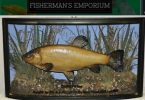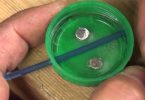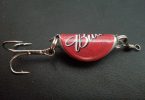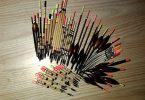When the 13th-century Germanic Emperor, Frederick II, decided on a novel use of his jewellery in the cause of science, he unwittingly started one of the first recorded fish-tagging experiments. The story goes that the Emperor wired one of his rings to the gill cover bone of a pike living in the royal lake at Mannheim (in what is now the state of Baden-Wuerttemburg, South-West Germany). The fish was released, and it was not until 1497, some 267 years later, that it was caught again, still carrying its unusual tag.
By then, if the tale is to be believed, the pike had a weight of 3501b and measured 19ft long. Irrespective of the fact that we now know that these dimensions are approximately five times greater than those which have been authenticated for any pike since, it has been calculated that a leviathan of that length would actually have had to weigh some 3,000lb!
It would be easy to dismiss the ‘Emperor’s Pike of Mannheim’ as just another weird-and-wonderful medieval legend. On one particular aspect, though, the story may be at least pointing us in the right direction. When considering the age to which fish can live, recent information from anglers has shown that truth really is stranger than fiction.
Much of our knowledge about animal populations has been obtained from detailed scientific investigations, backed by field observations made by naturalists. With fish, however, studying their natural history presents obvious, purely practical difficulties, and there are still many mysteries to be solved. Accordingly, the notebook records of anglers can provide valuable information about fish behaviour, and nowhere is this more true than with the question of fish ageing.
It was once widely thought that fish grew for most of their lives and that, once growth ceased, they died shortly afterwards. Most of the supporting evidence was derived from the standard method employed in calculating the ages of fish – examination of their scales.
Because fish do not add to the number of scales as they grow larger, they must increase the size of each scale to keep this suit of armour intact. The rate of growth is not constant throughout the year. In Britain, most growth occurs between late spring and early autumn, with little or none at all during the winter months. This check to growth in winter is recorded in a slowing down or halt to the increase in size of the fish scales. By removing a scale and examining it, scientists can count the number of winter checks and thereby age the fish. (Incidentally, this does no long-term harm to the fish, which grows a new scale within a short period.)
For most coarse fish, these ageing investigations have revealed a maximum growing period about 12 to 15 years, albeit that some, mostly smaller species are more short-lived. Until fairly recently it was assumed that fish died soon after growth ceased. But there is now incontrovertible evidence some fish have merely reached their early middle years at these ages.
The finding came about because of our ability to recognise individual fish. Just as the owners of cats or dogs are able to recognise their pets, anglers have found it possible to tell one fish from another of the same species. The key features vary with different types of fish, but in each case they seem to be as individual as the fingerprints of human beings.
This is most obvious, perhaps, with coloured koi carp. In Japan, the fish are treated almost as members of the family, and they are passed on from one generation to another. As a result, there are innumerable records of koi carp older than 50 years and of many which have lived to more than 100. The oldest is ‘Hanako’, a female fish living in a pond in Higashi Shira-kawa, in Japan’s Gifu Prefecture. In 1974, she was aged at 228 years!
For the individual identification of pike it is the precise pattern of blotches and bar markings, especially near the ‘wrist’ of the tail, which is important; in grayling and brown trout, the number and position of the small, coloured spots on their flanks is the key; and for partially-scaled mirror carp, the scale arrangements are the give-away feature. It is worth remembering, though, that the features are different on the two flanks of a fish and the same side must be studied on each occasion.
Further information on fish ageing comes from known fish which have been kept in captivity for considerable periods. One of the most famous was the former record carp, a fish nicknamed ‘Clarissa’, which was caught from Redmire Pool, near Ross-on-Wye. The carp was transferred alive to the aquarium in Regent’s Park Zoo, where it lived until its death in 1971.
Scales taken at the time of capture, in 1952, revealed that the fish was aged 15 years. However, another scale reading after its death showed there to be between 13 and 15 growth checks on the scales – even though it is certain that the fish was 34 years old when it died. The reason for the apparent discrepancy is simply that, during its captivity, no growth had occurred.
The belief that some of our fish can live to a markedly older age than ‘Clarissa’ is supported by the capture records of another Redmire carp, Chris Yates’ former record, weighing 51lb 8oz Between 1959 and 1980, this carp was caught on at least nine occasions. A scale taken in 1966 showed it to be 15 or 16 years of age. So, if the fish was aged correctly, it must have been about 30 years old by 1980. If, as many anglers suspect, it was a survivor of the original consignment of fish stocked into the pool in 1932, it may have been 50 years old when it achieved record status.
Among other examples: in 1948, the death was reported of an 88-year-old European eel named ‘Putte’ in an aquarium at Halsingborg Museum, southern Sweden. She was reputedly born in the Sargasso Sea, in the North Atlantic, in 1860 and was transferred into captivity as a three-year-old elver. Nearer home, the oldest known goldfish was a specimen named ‘Fred’, owned by Mr A.R. Wilson, of Worthing, West Sussex, which died on August 1, 1980, aged 41.
It is tempting, but erroneous, to regard such fish as freaks of nature; many more examples of long-lived fish are only now beginning to come to light as anglers gather and publicise their evidence.
But what is the significance of this information? To many of Britain’s two million coarse anglers, it confirms what most of them have always suspected… that fish which are unhooked carefully and returned alive to the water do, indeed, live on to grow bigger. Because that is one means of ensuring their sport in future years, this understanding provides anglers with real incentives for improved methods of fish handling and care.
For fishery managers, the knowledge that big fish can live on to great ages is equally important. It provides them with the reassurance that, if a fishery is managed correctly, it may be unnecessary to stock with additional fish, even if successful fish spawning has failed to take place. For fisheries scientists, too, here is the ideal opportunity to carry out studies into the little understood subject of fish behaviour by tapping into firm records of longevity.
What is certain is that, for a sport in which approximately half of all anglers are aged 34 or less, some of the fish they catch will be older than themselves. It is a sobering thought that an individual fish may not only be able to outwit an angler throughout its life but also to outlive its would-be captor!
**********
Prepared by: Dr Bruno Broughton
bruno.broughton@virginnet.co.uk
[05 October 2000]







